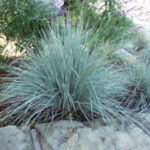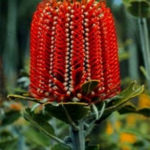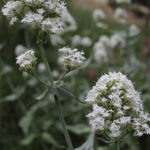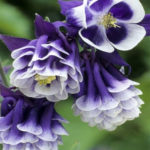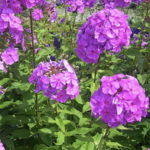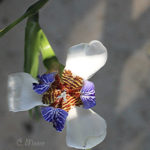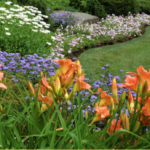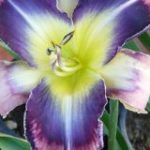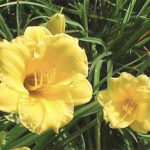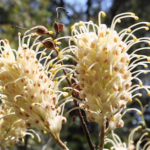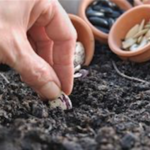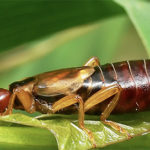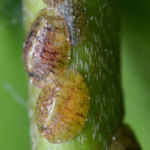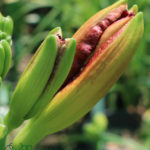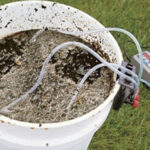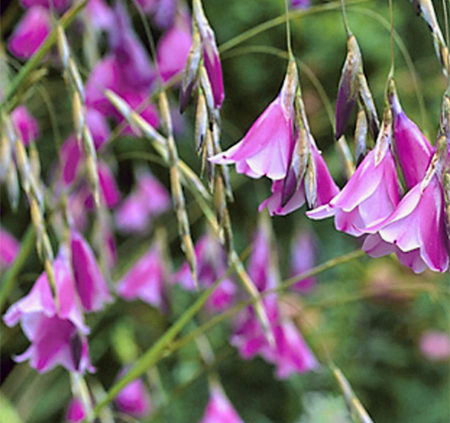
Dierama Fairy Fishing Rod
Fairy’s Fishing Rod – Angel’s Fishing Rod – Fairy Wand – Wandflower
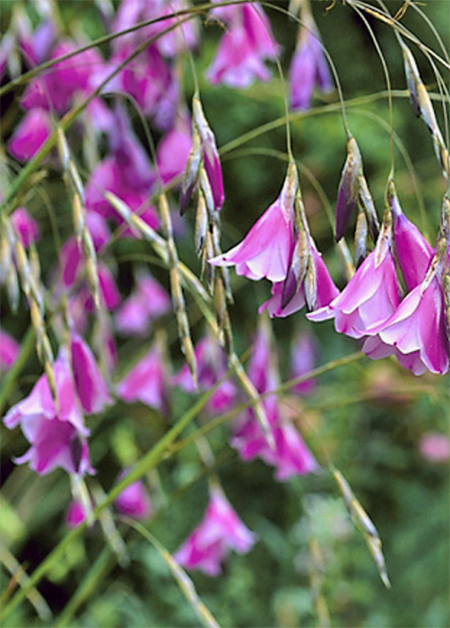 Fairy’s fishing rod or Dierama pulcherrimum flowers is also known as angel fishing rods and hair bells. This plant is native to southern Africa but grows well in Australia when the conditions are right. They are perennial plants with tuffs of arching grass like foliage and bell-shaped mauve, pink, burgundy or white flowers, hanging from the end of long stems that look like ‘fishing rods’. The plant creates a great deal of stems that bends and sways with the weight of flowers. Even the gentle breeze moves the flowers. Flowering occurs during summer and the stem can grow to a height of 1m-1.5 m. Once established they multiply at a moderate rate. The flowers are suitable for cutting.
Fairy’s fishing rod or Dierama pulcherrimum flowers is also known as angel fishing rods and hair bells. This plant is native to southern Africa but grows well in Australia when the conditions are right. They are perennial plants with tuffs of arching grass like foliage and bell-shaped mauve, pink, burgundy or white flowers, hanging from the end of long stems that look like ‘fishing rods’. The plant creates a great deal of stems that bends and sways with the weight of flowers. Even the gentle breeze moves the flowers. Flowering occurs during summer and the stem can grow to a height of 1m-1.5 m. Once established they multiply at a moderate rate. The flowers are suitable for cutting.
Growing Condition
This plant variety requires a sunny position and fertile loamy soil, which is well drained but moist for their proper growth.
It is best to grow them in built up soils, to avoid water logging of the corms in winter and prevent the soil from drying out during summer.
Amending the soil with organic matter before planting ensures healthy growth.
In the colder region, the plant may require mulching.
Fairy’s fishing rod can withstand light frosts.
While the Fairy’s Fishing Rod plant requires moderate care, the leaves need to be cut back in spring to keep the plant tidy.
They can be grown as flower borders or in garden beds, as well as they can also be grown in pots or containers.
They look great when grown along with other ornamental grass varieties.
How to Grow?
Dierama pulcherrimum can be planted during spring or in autumn. You can start the plant from corms or from seeds. Plants started from seeds will take 5 to 7 years for flowering. Seeds can be sown during spring or autumn. Sow the seeds on the surface of the soil which is moist. The seeds will take 1 to 6 months to germinate. Transplant the seedlings during the next spring. Growing the plant from corms is the faster method to produce plants that bloom early. Corms can be planted in spring at depth of 5 to 7 cm in the soil. When transplanting the seedlings, leave a spacing of 6 to 20 inches between the plants.
How to Take Care of Fairy’s Fishing Rod?
- Fairy’s fishing rod requires at least 3 years of growth to produce flowers.
- Make sure that the soil around the plant is moist during the growing season.
- When the temperature starts to dip the plants grown in containers should be brought indoors.
- Reduce watering the plants during winter.
- Fairy’s fishing rod doesn’t get seriously affected by pests and diseases.
- You can fertilise the plant at the starting of the growing season using diluted house plant liquid fertiliser or general-purpose fertiliser like blood, bone, and fish.
- These semi-evergreen plants require very little pruning. Any pruning needed should be done during spring.
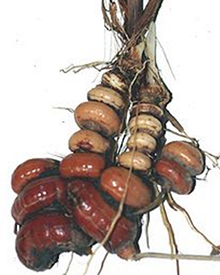 Division of Clump
Division of Clump
These plants tend to form clumps once they get established. Flowering may decrease after five years, after blooming starts and the plant may become overcrowded. The plant can be divided after flowering or in early spring. Dig up the corms that are growing vertically. Divide the plant in to smaller clumps and single corms. While digging the clumps if you are familiar with crocosmia corms you will notice that these corms grow in the same manner and are alike in size, shape, height and width. And that the corms multiply one after the other, forming a chain of conjoined corms all joined together or stacked upon each other. Each year a new corm builds up on top the old corm. You can twist to separate the top corm to start a new plant and lay the others out too and they will eventually grow new corms and flower. It is only the top corm that flowers as you can see in the photo.
Plant the divided clumps in a new location or in pots. Care should be taken to avoid damages to the brittle roots. The plant doesn’t like to be disturbed and may not flower in the year after division.


